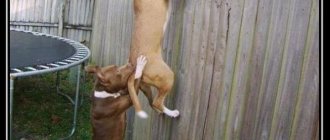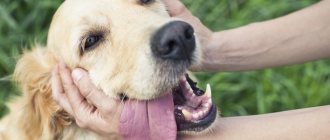Surely, many dog owners are familiar with the situation when a dog runs away during a walk and does not react in any way to the owner’s calls to come over. Very often I notice couples who generally walk on their own: the dog is alone, and the owner, somewhere on the sidelines, patiently waits for his pet to walk up and come to him, because calling and catching him is useless. For the same reason, many generally prefer not to let their four-legged pet off the leash. Yes, precautions will not hurt here.
But you don’t always have to lead your dog exclusively on a rope. Sometimes you want to remove restrictions and give your pet freedom, so that the pet can play to its heart’s content with its fellow animals and run after the ball. After all, this is very beneficial for the dog’s health.
So what are the reasons for such “escapes” of the dog? What to do if this happens, and how to wean your little one from this habit?
The pet does not hear the owner
Why do you have such big ears? To make it hard to hear you!
As soon as the owner lets the dog off the leash, the dog’s ears are immediately blocked. Ignoring one's own name, master's calls and commands? I love it, I can do it, I practice it.
Such situations occur very often. The owner calls the pet to him, but he, being on free grazing, does not lead with his ear. In order to prevent such situations, the owner will have to take measures. Namely, let the dog off the leash only if the command “come to me” is immediately executed.
The owner is always to blame for a dog's misbehavior
However, owners do not always understand what exactly led to the emergence of a bad habit. Let's consider several typical situations.
1. You only call your dog at the end of the walk.
Soon the pet begins to understand that your command is associated with the end of the fun. The companion will resist with all his might and stall for time to find another 5 minutes.
2. You scold the dog after following the command.
Of course, the punishment is preceded by 10-30 minutes of ineffective shouting. However, for a dog these two facts are in no way connected. The shaggy friend thinks that he was scolded precisely for approaching, and not for disobedience.
3. You start running after the dog.
This also does not happen right away. You understand that the dog will not fit, so take the situation into your own hands. Most often, the pet is more agile and quickly turns pursuit into a game. The animal enjoys “catching up” and regularly forces you to catch itself.
Never repeat these mistakes. One incident can cause a pet to completely change its behavior. It will be difficult to wean yourself from a bad habit.
The dog walks on a tight leash
I walk as I please!
Another common problem that can be seen on city streets. The dog walks, pulling on the leash with all his might, and the owner simply holds on to it. The dog responds to any attempt at correction by proudly ignoring him. It seems that the dog is walking its owner.
In order to teach your pet to walk on a slack leash (at the left leg), you need to explain to him the following: it’s great to be around the owner! Walking with your left foot is what you need to feel comfortable. Therefore, the owner is armed with treats, toys and a lot of patience.
“Uninteresting” treat: should your dog work for your reward?
huffpost.com
There is an idea that dogs work for us and follow orders to please their owners.
This is a romantic myth that almost everyone accepts as true and therefore difficult to debunk. In fact, dogs pursue their own interests, knowing full well their own benefit. This data comes from the Association of Pet Dog Trainers (APDT). When they receive a command, they are likely to think, “What good does this mean for me?” see also
“Beware, angry dog” is not about them: 49 photo examples
By correctly using treats as rewards, you can really distinguish a dog that wants to work for treats from a dog that doesn’t care. Why should a dog bother if he is given something not very tasty as a reward? Using a treat that is too simple (like kibble) can be harmful unless your dog absolutely loves it. Especially in the initial stages of training or when something happens around you that distracts the dog’s attention. So make sure that the treats you reward your dog with are worthy of his attention.
Also remember to choose a treat that is soft, smelling and divided into small pieces. This allows your dog to quickly swallow the reward and return his attention to you rather than being distracted by eating a larger treat. Try using what veterinarian, trainer, and author Dr. Ian Dunbar calls the "Ferrari of dog treats": freeze-dried liver. In this cooking method, moisture is removed from frozen liver in a vacuum environment. Therefore, the liver, while retaining all its nutritional properties, turns into small, light pieces that are convenient to give to the dog, encouraging it to do what you want it to do.
The animal picks up from the ground
And here we are...indulging in some tasty treats!
When a pet “flies” or “vacuums”, his hands give up from powerlessness. Not only is this behavior negative, it is also dangerous. A dog can eat something nasty and get poisoned. The consequences are sad: poisoning and veterinary clinics, IVs, surgery. And in the worst case, death.
It is quite possible to eradicate the habit of using a “vacuum cleaner”. If the dog aims to grab something from the ground, pull it back sharply and give a prohibiting command. As soon as the pet is distracted from the “treat”, immediately switch it to yourself, already to the real treat.
Unclear Signals: Perhaps you are confusing your dog?
thebark.com
Dogs perform actions sequentially, and they are better at this than humans. So make sure you always use the same command. At the same time, make sure that other dog trainers do the same. If you force your dog to perform a command, and he just sits and looks at you, then think about whether you are using this command consistently and constantly.
You can often find a family in which the wife uses the word “come” to call the dog, the husband calls the dog by name, and the children simply say “here!” Never give a command in different ways and make sure your body language matches the verbal command.
Accompany the command with a specific gesture and do not change it, because dogs are very attentive and read body language faster than verbal signals. Also, try your best not to repeat commands over and over again. Otherwise, the dog will stop hearing you. She will learn not to follow the command after the first time, but will instead wait for you to finish the phrase!
see also
65 photos of dogs that found their way to their owner's heart through funny poses
Aggressive behavior
I'll bite you now!
It is almost impossible to eliminate it on your own; you need to seek help from a professional dog handler.
Dogs show aggression when they are afraid of something. This sounds strange, but it is true. This type of aggression is called passive-defensive; it is characteristic of pets who are insecure. A strong, confident dog will not attack just like that.
Unfortunately, many owners are touched when a puppy barks at a passerby. Even owners of large breeds are guilty of this, let alone small dogs. But time passes, the puppy grows and turns into a huge beast, frightening people with its very appearance. Imagine how a random passerby feels when a German Shepherd, Rottweiler or Giant Schnauzer growls, barks and lunges at him. And the problem...is the owner of an aggressive dog. Why did they bring the situation to this point without taking any action?
The second point is zoo aggression. There are dogs that react extremely inappropriately to their own kind. Some pets have it in their blood, even if you correct it or not, the result is the same.
However, even such a dog can be switched to something other than its four-legged counterpart. Switching is done with the help of the owner, treats or toys. Having seen another dog, the owner should take his own dog on a short leash, call him by name, and wait for him to pay attention. And then the command “near” is given, the dog is shown a treat or a toy, depending on what it likes best.
Why do dogs run away?
Before deciding how to behave if a dog runs away from you, you need to find out the reasons for its behavior.
Predisposition to free life
There are animals that do not need people at all. They feel quite comfortable in the absence of their owner. Such animals can change several owners throughout their lives, and will run away from them at every opportunity.
Fear of the owner
Often a dog runs away during a walk, experiencing fear and mistrust of its owner. This may be due to cruelty to the animal, excessive severity or coldness. Very often, obeying ancient instincts, our pets are not averse to wallowing in rotten meat.
Having called the offending dog, the owner begins to shout at it rudely and irritably, punishing it for its offense. But the dog sincerely does not understand that he is being scolded for getting dirty. He begins to think that the owner is angry with him for coming up.
If you call an animal only to reprimand it, it develops the “come and get” reflex. And next time he will not have the desire to approach, because he will think that he will now be punished.
The menacing intonations of your voice
Animals are very sensitive to your mood. If you are irritated, then most likely your pet will try not to come close to you. He can walk nearby, run around the owner, but not come closer.
Pet's age and temperament
As a rule, very young puppies (from 3 to 5 months) are not prone to escape. They are simply still afraid of everything and try to stay close to their owner. And many owners of four-legged animals, rejoicing at such “obedience,” mistakenly believe that this will continue to be the case. But this is far from true.
Having reached sexual maturity (at the age of approximately 5-8 months), four-legged animals begin to actively and fearlessly explore the world. According to statistics, it is at this age that a large number of “losses” occur, since in addition to the curiosity of the tailed animals, there is also the inexperience of animal owners who have never had a dog before and who do not know this peculiarity of the behavior of four-legged animals.
The prize here can be given to both young and curious pets and dogs of hunting and very active breeds (Jack Russells, miniature pinschers, greyhounds, and so on).
Panic fear
Very often, a dog runs away from its owner due to panic. The sounds of fireworks, firecrackers, the roar of a helicopter or tractor can frighten a pet so much that out of fear he will run “wherever his eyes look,” without seeing anything or hearing the owner’s shouts.
The dog is interested in something
If you are carried away by some object or playing with other dogs, your pet may simply not hear you. You can shout until you lose your voice: “Come to me!”, but it won’t do any good.
It is quite understandable that if a dog is carried away, it will run after the object of its attention. As a rule, after a few minutes the animal comes to its senses and begins to look for its owner, as happened in the case of our Jackusik.
But a more difficult moment is when a male is attracted to a female in heat. It’s unlikely that in a couple of minutes he will remember you. Therefore, if you notice that your male dog begins to behave strangely, run from side to side and sniff out marks, immediately put him on a leash.
Leash as the end of a walk
Many dog owners, having called their pet to them, immediately fasten the leash and lead their four-legged dog home. The dog has an association: when he approaches the owner, the walk is over.
Yes, any walk ends when you go home. But so that your pet does not get the feeling that they are calling him only to take him home, take a little walk, run with the animal, even if your dog is already on a leash.
Insufficient duration and activity during walks
Very often dogs are in no hurry to approach their owners due to the fact that they have not had enough exercise. And our pets don’t care whether you’re late for work or not.
If you walk your dog too little, then it simply may not have time to fulfill its natural needs, or it may not have enough time to communicate with other animals. The dog runs away, trying to delay the moment when it will be left alone after you leave for work.
Lack of authority from the owner
Very often, those owners who always indulge the animal in everything are afraid to let their pet off the leash, as a result of which the authority of the owner in the eyes of the pet is lost. If there is no authority, then what orders can there be? When I had my fill, then I came.
Ignorance of commands
Often dog owners (especially miniature ones) do not consider it necessary to teach their pet commands. To call the four-legged dog to them, they can use different expressions: “Come here,” “Let’s go home,” or simply whistle or call. As a result, the animal does not develop a clear reflex to a particular command. And if today the baby reacts to such a phrase and comes up to you, then tomorrow he won’t even move his ear, no matter how much you scream.
Jumping on strangers
May I introduce myself, lady?
A dog that is too affectionate is no less a headache than an aggressive one. Some breeds simply love attention. And in order to receive it from a person, they jump on him, joyfully greeting him.
It’s one thing when a dog jumps on its own owners with their connivance. But the problem is that the dog decides: since it is possible to jump on the owners, then other people are happy with such a greeting.
In order to wean an animal from jumping on people, you can do the following:
— put your knee forward and lightly push the jumping animal with it, while simultaneously giving a braking command. After this, give the command “sit”, wait until the dog completes it, and reinforce the correct behavior;
— at the moment of the jump, sharply turn away from the animal, standing sideways to it and placing your elbow on the animal’s side. When attempting a new jump, repeat the action. And so on until the dog calms down. Of course, it is unlikely that a passerby on whom a dog is jumping will resort to this humble method. But the owners are quite capable.
How Jackusik went on the run
When Jack was about 1.5 years old, we also faced a similar situation. Any Jack Russell Terrier benefits from active walks and good exercise. Therefore, from time to time, we let Jack off the leash so that he can run around and play to his heart's content.
Of course, we try to make such “free” walks as safe as possible, taking them away from roads and unfamiliar dogs. But one day, while walking, a rather charming tailed girl suddenly ran up to us. She was wearing a collar, and we had no reason to worry, since sometimes we saw her together with her owner; Jack even played with her a couple of times. Moreover, by all indications, she did not have any “interesting” days.
Here we decided that we simply hadn’t noticed the hostess, and she was about to come up. But it was not there. There were no owners nearby. After frolicking for a couple of minutes, the girl apparently got tired of it and decided to run on, minding her own dog business. Of course, Jack followed her.
The further they ran from us, the less hope there was that Jack would turn around and run back. No matter what his name was, he did not react. He was just so carried away that he didn’t even hear our (by that time) hysterical screams and calls to return. For a moment Jack stopped, wondering who to go to. And then we made a fatal mistake at that time: Artyom ran after him! At such moments this should not be done under any circumstances.
Seeing Artyom chasing him, Jack was so happy that he ran after his tailed friend even more. As he ran, he looked back and, seeing that his entire “flock” was running after him, he was completely calm. He probably thought, “Yo-ho! How great! I run, the owner supports my game and runs too! How we play cheerfully and harmoniously!” Yes, most likely Jack took it as a game.
Dogs run much faster than people, and in just a few seconds this tailed pair disappeared from view. We started to panic. We ran around all the nearby courtyards, looked into all the nooks and crannies, asked passers-by, but no one saw him.
About an hour and a half passed, which seemed like an eternity. The dog was nowhere to be found. What to do, we decided to take the “escape” route again and try other ways to find the dog.
But a miracle happened! Returning to the clearing where everything happened, we saw our impudent red, spike-butted muzzle rushing towards us from behind the neighboring house, “in full sail,” with eyes full of horror.
There was no limit to happiness. Everyone was so happy, as if they had not seen each other for 10 years. I cried, Jack jumped and licked us, whining with happiness. You could see him asking for forgiveness. We didn't scold him. He himself was very scared. Apparently, having played too much, he did not notice our absence, and at some point, not finding us next to him, he got very scared and ran back.
We were lucky that everything ended well and he found his way himself. He didn’t end up on the roadway and that strangers didn’t even just take him away. Now Dzhekusik is already 6.5 years old and he is very attached to us. But even now, I try to let him off the leash only where he will be completely safe.
It is quite normal that during a walk your dog sometimes runs away from you and then comes running again. But now, when Jack hesitates and we find ourselves at a decent distance from each other, I never run after him, trying to catch him. I act completely differently. How? Read on.
The dog runs ahead
And close, and not.
Another unpleasant moment. The dog seems to be walking alongside, but pulls ahead by almost half a length. Some people do not pay any attention to this behavior of their pet, while others find it annoying. The owner tries to correct the dog with a leash, but the results are not crowned with success.
In this case, a treat or toy will help the owner. With its help, the dog is forced to walk correctly, otherwise the pet will not see the desired thing. That is, a treat or toy is held in the left hand so that the dog becomes interested and concentrates on it, moving next to the owner, as expected.
Freedom in the blood and a tendency to escape
In many ways, the character of a pet depends on genetics. Genetics, in turn, is determined by a person. We breed dogs for specific purposes. Some are ideal for hunting, others help save people. Certain traits are carefully maintained in the breed. Not all of them are convenient for owners. Some working animals enjoy freedom and rely less on a bond with their owner.
Which dogs should you take into your home with caution? There are always exceptions, but most often fugitives are found among pointers, hounds and sled breeds. Such pets must be trained from early childhood and their behavior must be constantly monitored. This is hard and painstaking work. Any mistake can lead to dire consequences, so it is better to think in advance about whether you can cope with an overly active dog.
Emotional problems: do emotions get in the way?
leaderdog.org
If your dog is scared, anxious, or nervous, his emotional state may interfere with training. This is because dogs are often in a fight-or-flight state, which affects their cognitive function and impairs their ability to learn. In this case, you may have to work with your dog in a place where he will be less afraid if the street, people, cars or something else scares him. Then gradually introduce more and more stimuli so that the dog gets used to it and does not react to its environment.
see also
17 Photos of Huge Dogs That Still Think They're Puppies
If your dog is scared of thunder, instead of immediately letting him listen to recordings of the thunderstorm through the speakers, you should first play it at a very low volume so that the dog recognizes the sound without being scared. Remember to reward your dog while the sound is playing. Over time and over multiple training sessions, increase the recording volume. This process is known as desensitization and is a common technique used in dog training.
How to find a dog?
If the pet does run away, search efforts should begin as early as possible. Useful tips:
- First of all, walk along the usual walking route, looking into all secluded places - basements, trash cans and bushes.
- While searching, take your favorite squeaking toy with you to attract attention with sound.
- Write an ad and post it in the area of the loss. It is best to use bright paper and attach a photo and description of the pet. It is advisable to place it on porches, poles, as well as in the nearest veterinary clinic and pet store.
- Post an ad on social networks, for example, in a thematic group in your city. Offer a reward, but do not indicate its amount (resale may be more profitable than the offered reward).
- If the dog has just run away in an unknown direction, ask passers-by.
- Before entering the house or near the entrance, leave your item with a scent so that it is easier for the dog to find the trail back.
- View video camera recordings in the city - some providers place video surveillance in courtyards, near city attractions and provide access to them for free.
- Call all city shelters, veterinary clinics and crematoriums for animals.
You should approach writing your ad wisely. It is not recommended to indicate all signs - this can protect you from scammers and accurately determine the signs of your pet during a call. You should not indicate the nickname, as this will help the dog adapt faster to its new owners.
Be sure to place an address tag on the collar indicating contact numbers and some emotional phrase, for example, “they are waiting for me at home.” The search for a runaway pet can continue for quite a long time; do not become discouraged if there are no results for a long period. The dog can run very far from home, starting from the second week, the search can begin in nearby cities.
Photo: flickr.com
Causes of deafness in dogs
The main reasons for the development of the disease are:
- genetic conditioning (hereditary pathology);
- infectious diseases during intrauterine development;
- ear injuries (damage to the eardrum or ear canal, complications of otitis media, tumors);
- violation of the innervation of the inner ear (infectious and autoimmune diseases);
- circulatory disorders in the auditory organ;
- blockage of the ear canal (wax plugs);
- bacterial, viral and parasitic infections;
- side effects of drugs during long-term therapy;
- old age of the dog.
Quite often, dogs experience persistent hearing loss, up to its complete absence.
Results about disobedience
One of the most important reasons for disobedience is fear of the leader. If you are too impudent, cold and aggressive, then the dog is simply afraid of you. Even if you are in a bad mood and somewhere took out your anger on the dog, it will constantly think that it is she who is the cause of your dissatisfaction and irritation.
Even when she approaches you, she will be scared, with her head down and her eyes drooping. Try playing together, hugging and petting the animal. Maybe you should give her a treat, just not for the team. Praise her for coming to you. Create situations where the animal will feel loved and needed. This will bring much more positive emotions to the relationship than from swearing and aggression. And always remember that the more anger you show, the greater the chance that one day the pet will break loose and attack you with a retaliatory blow. Evil begets evil, and good begets good, remember this.
Currently reading:
- Recommendations for obedience of a dog if it growls
- Games to choose for training a dog
- The American Cocker Spaniel is an adroit hunter and loyal friend.
- Tips for proper dog burial
The dog doesn't listen to me: the problem is communication
For both humans and the dog world, we must understand and establish a reference code with which we can navigate communication with our four-legged interlocutor.
We must start with a fact that may seem surprising to some: not all dogs that disobey are incurably stubborn and disobedient! Communication problems often arise. So, let's try to “tune in to the same wavelength” with our four-legged friend. The dog must understand that you are the leader (guide) of the family. Only when the dog recognizes you as a guide will it be ready to accept your scolding.
How to catch a fugitive
If your dog runs away, there are several ways to catch the fugitive.
Play hide and seek with your pet
If the dog runs away from you, it is necessary to form a new behavior pattern in which the dog will be forced to constantly monitor you. There is a very effective way to prevent escapes and it is called “Hide and Seek”.
While walking with your pet, hide behind a tree or bush. At the same time, always keep the tail in sight. Next, say his name out loud.
The baby will definitely start looking for you, and when he finds you, he will be very happy. When leaving the shelter, rejoice wildly with the dog, praise it, and treat it with a treat.
I started playing a similar game with Jackusik at home, when he couldn’t walk outside due to the lack of all the necessary vaccinations.
In case of escape, be unpredictable
If a dog runs away from you, do something unpredictable, because a dog that is carried away by something may not hear its owner’s calls to return.
Make your client feel jealous
If the pet ran away far
If you caught up with the runner and were able to silently approach and grab him, this is exactly the situation when you can scold the four-legged one. If the fugitive, noticing you, comes up on his own, there is only praise and joy!
If the situation is absolutely critical, ask other dog lovers for help in catching the fugitive. And the owner of the bride himself will most likely help you.
If your dog keeps running away from you, the first thing you need to do is establish contact and complete trust between you and your four-legged dog. This is the only way you can solve this problem.
Well, if it happened that your dog ran away, you need to take all necessary measures to find it. Read more about how to find a missing dog. Be sure to attach an address tag to your pet's collar with the dog's name and your phone number.
In conclusion, I suggest watching a video lesson from the famous dog handler Antoine Najarian, who will tell and show how to control a seemingly uncontrollable dog while walking.
Dog Ignores Me: Body Language Is Important
First of all, we must start from the assumption that dogs pay much more attention to “body language” than humans. It interprets our movements and posture very accurately. Therefore, we must pay close attention to how we approach the animal.
© shutterstock
So, keep in mind that there is nonverbal communication that goes from the direction of our gaze to the way we lean. Let's start by analyzing the use of our body in dialogue with our dog.
The dog is ignoring me, two basic tips:
- Avoid too fast and sudden movements;
- Circular paths are preferable to "straight" gestures, forward: it is better not to lean with a feeling of almost concern, but to bend with your feet and extend your arms, as if to inspect the animal.
Always remaining in the orbit of non-verbal but visual communication, let's analyze the correct strategy to apply to the dialogue with the dog in relation to our facial expressions. Even our facial mimesis is crucial in the economics of communication with a pet.
For example, we should avoid laughing at a dog's inappropriate but funny behavior so that it does not perceive gestures that should be avoided as gestures that make us happy.
Treatment of the disease
Congenital deafness cannot be cured. In most cases, the dog adapts to its position in childhood and does not suffer from its deficiency. Personalized hearing medications can sometimes be used, but they are often disruptive and are not always well received by dogs.
Treatment of acquired deafness is aimed at eliminating the main causes of the disease, identified during diagnosis:
- When the ears are clogged with wax, competent mechanical cleaning of the ears is sufficient. It is better if a veterinarian does this.
- If there is an inflammatory process in the internal structures of the ear, then, after stopping it, the ear is washed with antibacterial agents. In addition, general antimicrobial therapy is used to speed up recovery. During treatment, it is necessary to limit the dog’s exposure to the street to avoid complications.
- If the eardrum is damaged and purulent exudate is released, the affected ear is cleaned and antibacterial therapy is used to prevent complications. Such lesions should be treated with rest. After a few days, the patient's condition should improve significantly.
- There is no cure for senile hearing loss. The owner must help the dog adapt to its disadvantage. In some cases, commands are taught using gestures. It is recommended to walk with a deaf dog while keeping it on a leash.
How to make a diagnosis
If deafness is suspected, the animal is taken to a veterinarian. Only a doctor can make a competent diagnosis in a clinical setting. After checking the dog’s reaction to sound stimuli, he will prescribe an additional examination to diagnose the disorders that caused deafness:
- Examining the ears with an otoscope will help identify conductive abnormalities - the presence of pathologies of the auditory structures and ear canals.
- X-ray examination, as well as MRI and CT diagnostics are aimed at identifying the presence and nature of pathologies in the internal parts of the ear and brain.
- A neurological examination is aimed at identifying neurosensory disorders and the condition of the auditory nerve.











